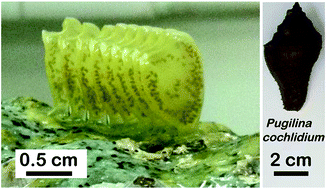Integrative and comparative analysis of coiled-coil based marine snail egg cases – a model for biomimetic elastomers†
Abstract
Integrative and comparative analyses of biomaterials systems offer the potential to reveal conserved elements that are essential for mechanical function. The approach also affords the opportunity to identify variation in designs at multiple length scales, enabling the delineation of a range of parameters for creating precisely tuned biomimetic materials. We investigated the molecular design and structural hierarchy of elastomeric egg capsules from the marine snail Pugilina cochlidium (family Melongenidae) and compared these data with all available published studies in order to infer the structure–property relationships of the egg case from the molecular to the macroscopic scale. While mechanical similarities had previously been observed for two other marine melongenid snails, Busycotypus canaliculatus and Busycon carica, B. canaliculatus was the only species for which detailed molecular and nanostructural data were available. Egg capsules from P. cochlidium were found to exhibit mechanical properties and shock absorbing potential that was similar to B. canaliculatus. The two species also displayed similarity in hierarchical fibril bundling and a sub-micron staggering of 100–105 nm within filaments, as shown by atomic force microscopy and small angle X-ray diffraction. In situ Raman micro spectroscopy indicated that P. cochlidium egg cases undergo a stress-induced coiled-coil to extended β-strand structural transformation that is very similar to that of B. canaliculatus. These observations supported the view that these structural and hierarchical elements are essential for egg case function. Comparative analysis of the primary amino acid sequences and structural predictions for all known egg case proteins suggested that while the proteins all contain sequences prone to adopt α-helical structures, the predicted location of coiled-coil domains and stutter perturbations varied within and between species. Despite these differences, mixtures of denatured native egg case proteins readily re-folded in citrate–phosphate assembly buffer into α-helix rich, coiled-coil based oligomers, as determined by attenuated total reflection Fourier transform infrared spectroscopy, circular dichroism and MALDI-TOF. It is concluded that both conserved and divergent designs in marine snail egg cases offer inspiration for the engineering of biomimetic elastomeric materials with a unique capability for mechanical energy absorption.

- This article is part of the themed collection: Emerging Investigators

 Please wait while we load your content...
Please wait while we load your content...